Susan Signe Morrison's Blog, page 3
December 20, 2017
God Jul! My Ancestors Crafted Beowulf’s Armor…and other lessons from the classroom
My grandfather, Werner Wehlen, in his 80s.
God Jul! My ancestors crafted Beowulf’s armor. Ok, maybe it’s a stretch. Earlier this semester, one of my students blurted out, “That means your great-grandparents made Beowulf’s armor!” I’d like to explore the justification for this suggestion on this day, in memory of what would have been my mother Joan’s 95th birthday.
Her father, my grandfather Werner–who called himself a Viking–was born in the 19th century in Sundsvall, Sweden. He grew up on a farm where tomtens knotted the horses’ tails every night. The milk Werner left out was always drunk by them. So he maintained.
[image error]
His little footprints in the snow….
This old Swede, as I knew him, said he was descended from Weland or Wayland the Smithy, the smith god in the Norse and Germanic mythological panoply. After all, his last name was Wehlen, though my Swedish cousins spell it Welin. So when Beowulf talks about his armor as “Welandes geweorc” or “the work of Weland” (line 455), that must be my ancestor’s artistry at play–at least according to my student. I like to think that’s true.
[image error]
Oh! You’ve caught a glimpse of him!
In case you don’t believe in the tomten, see this book by Viktor Rydberg, which features the beautiful paintings of Harald Wiberg. Below is the very copy my second cousin, Barbro, sent to my brothers and me in 1963. I still read it out loud to my children, just as my mother, Joan, did, on a still Christmas Eve. Maybe Weland is listening, too?
[image error]
The copy sent from Sweden to New Jersey.
[image error]
The inscription from almost 60 years ago.
Filed under: Blog








December 5, 2017
“Old English is Mine!”: Diversity and Old English — Part 2
Nahir studies medieval literature and culture.
I love what happens in the classroom. Just before the end of our penultimate day discussing Beowulf, one of my students burst out, “How is a brown girl like me supposed to identify with Beowulf?”
The next class we discussed issues of diversity and how we can use them to explore Beowulf and Anglo-Saxon culture. I shared with my students all sorts of material, including about Jorge Luis Borges, the brilliant Argentinian author who read, wrote about, and translated Old English literature. I shared an undergraduate honors student’s thesis written for me in 2004 called “Jorge Luis Borges: Nazi critic / by Andrew Edward Dunsky. We explored The Public Medievalist, a blog site devoted to defending medieval studies from white supremacist racist rhetoric.
Most importantly, I opened a page to my blog on Grendel’s Mother. This particular entry, called “Old English is Mine!”: Diversity and Old English, includes a poem by Nahir I. Otaño Gracia, the medievalist. She writes about how just because she is from Puerto Rico, she has “as much right to” Old English as anyone else.
I asked my student if she would be willing to read the poem—in both modern English and Spanish– aloud to the entire class. She was willing and sparked the most wonderful class. Later she wrote me, “I just wanted to thank you for showing me the poem in class. It was very empowering for me, and I’m very grateful for that.”
I’m grateful to my student, for opening the minds and hearts of all our students—and me.
And I’m especially grateful to Nahir for sharing this poem that allowed for a moment of grace in the classroom.
Filed under: Blog








November 30, 2017
Field Trip to the British Library, Anyone?
The pectoral cross from the Staffordshire Hoard, to be loaned to the Anglo-Saxon Kingdoms exhibition by Birmingham and Stoke-on-Trent City Councils (images courtesy of Birmingham Museums Trust)
If only I could take my students to the British Library next fall 2018. An amazing exhibit is set to open with all sorts of Anglo-Saxon material culture, including the Beowulf manuscript. Now we win the lottery…..
Filed under: Blog








November 27, 2017
Interview with the Society of Children’s Book Writers and Illustrators
Yes, it really is the ever gracious Daniel Radcliffe who takes selfies with the theater viewers of his magnificent performance in Tom Stoppard’s Rosencrantz and Guildenstern Are Dead in London (March 201&0rosten
I was so happy to be asked to be interviewed by one of my favorite organizations, SCBWI Austin [the Austin chapter of the Society of Children’s Book Writers and Illustrators]. This wonderful group supports beginning and expert writers in the field of children’s and YA lit. I have always found them to be delightful and helpful.
I never imagined they’d interview me. And little did I expect Daniel Radcliffe to show up!
Filed under: Blog








November 9, 2017
Why I love my students…Pop (Quiz) Art
“Pop quiz!”
I’ve taken to giving pop quizzes with easy answers…if you’ve read the material. When I told my students they’d have one everyday as we went through Beowulf, they said, “Then it’s not a POP quiz.” So I starting calling them “Pop-Tart quizzes.” In any event, I always say, if you don’t know the answer, make me laugh–or draw a picture. My students never fail me!
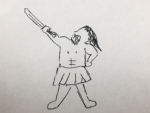
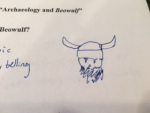

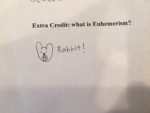
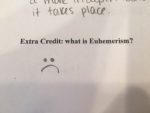
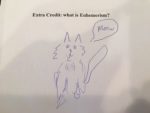
Why I love my students….let me count the ways…
Concerning Tolkien’s “The Monsters and the Critics”
What is or are NOT “an inexplicable blunder of taste”?
Literature critics
It is an inexplicable blunder of taste to neglect the study of Beowulf in scholarly settings.
My memory of what the answer to this question is
Dr. Morrison’s hair
Well…that’s debatable….
[image error]
Purple hair!
What does Leyerle argue about interlace in Beowulf?
No idea, so I drew Beowulf in a corset because inter[lace].

October 25, 2017
You know nothing, John Snow! Except how to weave a tapestry??
The heart-breaking moment Ygritte fires arrows at a fleeing Jon Snow
The Bayeux Tapestry beautifully depicts a Norman view of the political events culminating in the decisive loss of Britain for the Anglo-Saxons in 1066. Now, for those Games of Thrones fans out there (I am too! Team John Snow!), here is an amazing tapestry for you to enjoy.
Here is how they made it.
[image error]
E. H. Shepard once drew this amazing scene for an exclusive book bag
This style tapestry also inspired A.A. Milne of Winnie-the-Pooh fame.
I’m a Tigger girl myself…..
Filed under: Blog








October 13, 2017
Buy your mugworts here!
Can’t wait to use it!
Jessica Berry astounded us in the “Beowulf‘s Literary Hoard” class by her translation and presentation of the Nine Herbs Charm. Not only did she accomplish a lovely rendering into English, but she presented every student (and me) a jar with a skin product made from all the elements.
Jessica certainly enchanted us with her work!
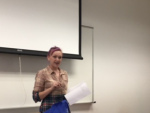
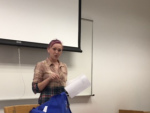

Filed under: Blog








September 8, 2017
“Grendel’s Mother” Joins List of 100 Must-Read Medieval Historical Fiction Novels
My own copy, clearly well-thumbed by both me and my daughter.
So excited that Grendel’s Mother has been chosen among 100 Must-Read Medieval Historical Fiction Novels by Book Riot. I’m especially honored since my novel is listed with other books I’ve long loved by authors like the incomparable Sharon Kay Penman, Tracy Chevalier, Sharan Newman, Melvyn Bragg, and Ellis Peters. I’m a newcomer, along with the wonderful Paul Kingsnorth, whose innovative The Wake I teach.
I was especially pleased since my novel sits in the same company of one of my favorite books of all time: Katherine by Anya Seton. I still remember where I first read it: on the main island of Orkney in late October 1994. My husband and I were living in London at the time and took a week’s holiday to that wind-swept area. Our self-catering home was nestled by the standing stones called the Ring of Brodgar.
[image error]
Ring of Brodgar
And I read for hours, chilled by the wind whistling around the panes, but warmed by the passionate intrigue of Richard II’s court and the tempestuous love affair between Katherine Swynford and John of Gaunt.
I like to imagine Katherine meeting my heroine, Brimhild. They would have a lot to talk about, especially how erotic desire can lead to great power but also to disaster and tragedy. Perhaps Seton’s book was, without my knowing it, influencing me as I wrote my own novel. They are set in radically different times and cultures, but one thing never changes: the power of women and the mystery of how they gain agency in a world designed to thwart their hopes and dreams.
Filed under: Blog








May 21, 2017
Book Award Finalist
Delighted to be chosen as a finalist in Adult Fiction
Grendel’s Mother: The Saga of the Wyrd-Wife (Top Hat Books, 2015) has been selected as a 2016 Wishing Shelf Book Award finalist in the category of Adult Fiction. This book has been a blessing! Thank you, Beowulf author[s], whoever you were!
https://www.thewsa.co.uk/finalists2016/
Filed under: Uncategorized








May 8, 2017
Spoiling the Mystery: Grendel in Beowulf Movies
Get your popcorn!
“The oldest and strongest emotion of mankind is fear, and the oldest and strongest kind of fear is fear of the unknown.” (H.P. Lovecraft, Supernatural Horror in Literature). The secret to any, successful scary monster story is to keep your monsters clouded in mystery; a secret that was known to the Beowulf poet, but sadly lost on modern movie makers.
Grendel goes to Heorot
Grendel is one of the three monsters that feature in the Old English poem Beowulf. We are introduced to Grendel as an “ellengæst” [bold spirit] (l. 86a) who has spent the last twelve years harassing the hall of the Danish king Hrothgar, devouring anyone who spent the night there. A Geatish hero, Beowulf, arrives to save the day. After a long battle, Beowulf rips off Grendel’s arm and the monster, mortally wounded, returns to his home in the swamp and dies.
A troll, a…
View original post 1,142 more words
Filed under: Blog












